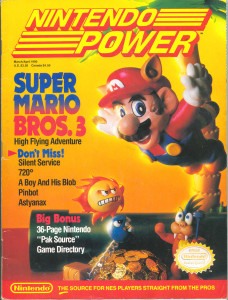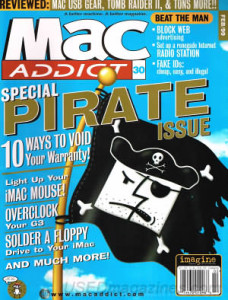Print is dead. That’s the first thing I think of when I think of magazines. But on reflection, I realize that I’ve had some special magazines in my life. Special to me, I mean. I don’t know how much of it is being a kid, and getting something in the mail that’s specifically for you, versus the actual content of the magazine, but I want to make an argument for the form that was the magazine – I will probably be really nostalgic, and I make no excuse for this. Its one of my favorite things 🙂
I’m sliding into my “mid-thirties”. Setting aside the panic that I occasionally experience realizing that I do in-fact age, it makes me appreciate that I have a handful of distinct decades of my life to reflect upon. I remembered a neat robot project from the staff of MacAddict (now Mac|Life) back around 2000/01. It made me think about magazines and realize that I’ve kind of had 3 magazines of my life. Magazines that meant more to me than just something to read.
Nintendo Power
 I don’t really remember when I started reading Nintendo Power. My best guess is third or fourth fourth grade. I also don’t remember why I wanted it, other than I was a kid with a Nintendo. About this time I was friends with another kid named Mike Roe. Mike was that kid1. The Kid who seemed to have all the Nintendo games, and all the NES accessories, and when the Super Nintendo came out, he got that too. I know for a fact that he introduced me to Nintendo Power, and I remember him sharing the super-secret knowledge that it had previously been the “Nintendo Fun Club” newsletter.
I don’t really remember when I started reading Nintendo Power. My best guess is third or fourth fourth grade. I also don’t remember why I wanted it, other than I was a kid with a Nintendo. About this time I was friends with another kid named Mike Roe. Mike was that kid1. The Kid who seemed to have all the Nintendo games, and all the NES accessories, and when the Super Nintendo came out, he got that too. I know for a fact that he introduced me to Nintendo Power, and I remember him sharing the super-secret knowledge that it had previously been the “Nintendo Fun Club” newsletter.
Anyway, because I loved Nintendo I loved Nintendo Power. I know I had at least the Ducktales issue, Volume 8, and the last cover that looks familiar to me is the Secret of Mana, Volume 54.
More than playing games, I think Nintendo Power invited readers to dive into the story of a game. Very often back in the 8-bit era, games didn’t have a ton of story behind them, just a little intro in the manual and it was all about gameplay (this rule excepts games like Final Fantasy or StarTropics). NP offered imaginings of the titles’ world, in hand-drawn, or occasionally modeled figurines. In retrospect, I think the creative additions to the magazine were of significant value to me. I didn’t have a ton of NES games as a kid, and certainly not the variety that were featured in Nintendo Power, but some of the editorial insights and artistic renderings gave supply to imagination that merely playing the game did not. I don’t recall making a specific decision not to renew my subscription. I assume that I simply became interested in other things.
MacAddict
 In my teenage years, I largely left the world of console video games behind. My attention and fascination swung heavily towards computers. Macintosh computers were my passion. Why Macs? Well – they were what I had in my house. At the time I had not gotten into development and so the absurd amount of work you had to put into using a program on Windows or MSDOS seemed like just poor design (It was in fact just poor design, but in retrospect I can appreciate why those other guys liked the IBM-compatible world)
In my teenage years, I largely left the world of console video games behind. My attention and fascination swung heavily towards computers. Macintosh computers were my passion. Why Macs? Well – they were what I had in my house. At the time I had not gotten into development and so the absurd amount of work you had to put into using a program on Windows or MSDOS seemed like just poor design (It was in fact just poor design, but in retrospect I can appreciate why those other guys liked the IBM-compatible world)
Back in the 80s and 90s there were at best, a handful of publications for Mac Users. The big guy in town was of course, MacWorld. There was Also MacUser, and MacWEEK (The latter being a weekly publication, looking much more like a newspaper). Out of all of those though, the one that I most connected with was MacAddict. MacAddict had a playful quality to it that the other magazines shunned in the name of business-like propriety. While they certainly championed owning a Mac, MacAddict’s modus operandi was to be absolutely crazy about your Mac. Their approach to writing and instruction was internet-scale snark 15 years ahead of the curve.
MacAddict had some cool features that really made it feel like more than a magazine. First they were really on top of their website. While it didn’t offer all the magazine had, they offered useful news, and frequent updates. They also included a CD with every issue, chock full of shareware, freeware, and demos of applications to try out. If you’re too young to appreciate this, there was a time when download speeds on the internet were really slow and downloading 10, 20 or even 100 megabytes was a long time – like, leave it up overnight long. Lastly, they always had some sort of staff video that was interesting, adorable, or downright shocking. It usually involved a few of the staff members demonstrating something, blowing something up, or working on some weird project.
My favorite memory of the MacAddict was the saga of the iBorg. The iBorg was arguably an experiment in telepresence robotics made by people who worked for a magazine company. You can see a video here of the building of the beast. The tale took a turn for the worse when the iBook that ran the whole thing was stolen.
If you want to gander at what the state-of-the-art web was like back in the late 90’s, have a look at MacAddict’s website, courtesy of archive.org
Make Magazine
 When I was 13 or so, I had an idea of starting a Toy Repair business. I had fixed one of my own toys and I thought it’d be a great idea. I setup a web page, and once even had an inquiry about fixing an old plastic molding machine. Then, once when I was 14 I tried my hand at fixing a walkman for one of my sister’s friends. Most people who talk about this stuff say they did it with everything. I didn’t, but occasionally I did dive into what would later be known as The Maker Movement.
When I was 13 or so, I had an idea of starting a Toy Repair business. I had fixed one of my own toys and I thought it’d be a great idea. I setup a web page, and once even had an inquiry about fixing an old plastic molding machine. Then, once when I was 14 I tried my hand at fixing a walkman for one of my sister’s friends. Most people who talk about this stuff say they did it with everything. I didn’t, but occasionally I did dive into what would later be known as The Maker Movement.
Make Magazine didn’t invent Making, but I do think it brought it out in the open. Making goes back (in my mind) to the guys who had a little machine shop in their garage in the mid-20th century. Guys who’d make an engine out of a block of aluminum or build a robot out vacuum tubes and resistors. That art slowly disappeared as globalization grew, but it’s back in the 21st century.
Acknowledging that print really is dead, I asked myself why I wanted Make Magazine. Magazines are typically far behind the times when it comes to information. That’s where Make ends up working out. Because the Maker Movement focuses on building, rebuilding, and tearing apart, it very often can fall in the realm of “timeless” projects. Sure the electronics may change for this or that, but at the end of the day you really gain something from the “why” as well as the “how”.
Perhaps even more valuable to me, Make Magazine started a yearly faire called MakerFaire. The tagline being “The Greatest Show and Tell on Earth”. MakerFaire is a Science Faire, Art Festival, and county faire rolled into one. Largely it’s a faire where you can bring something that you made, and show it off. I’ve presented at 3 in my hometown (Portland) and attended a handful more in the Pacific Northwest. It’s great fun and I highly recommend you attend one if possible.
1. Mike Roe is now a news producer and writer down at KPCC Southern California Public Radio. I reconnected with him a couple of years ago and he’s a pretty cool guy these days. His twitter account is @MikeRoe, and you can find him here
